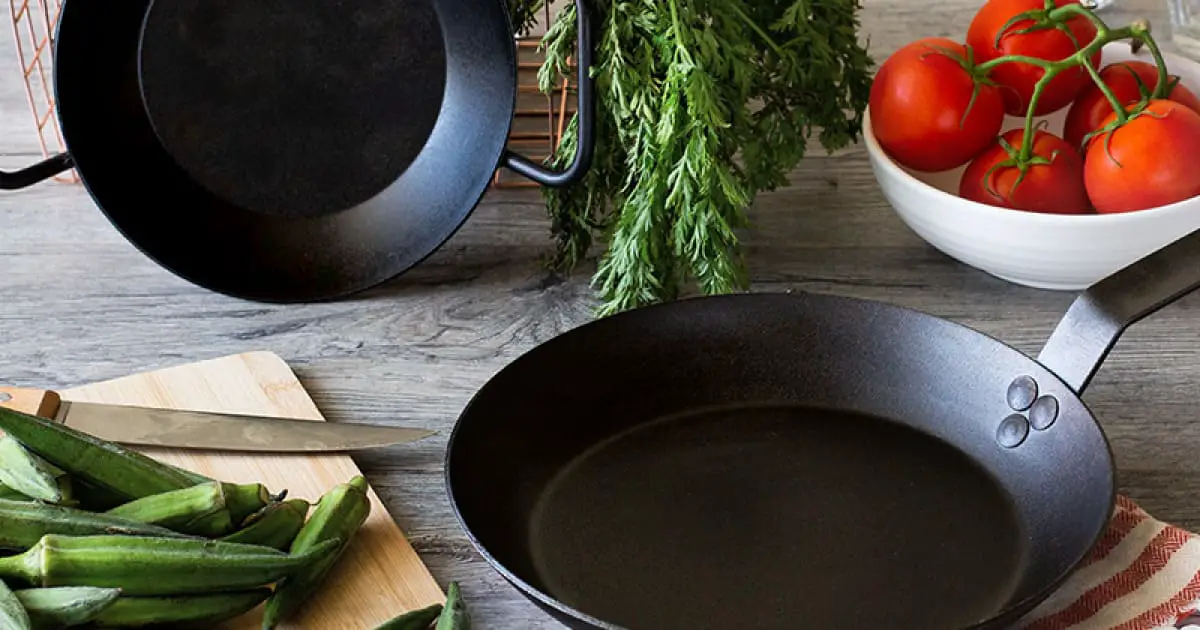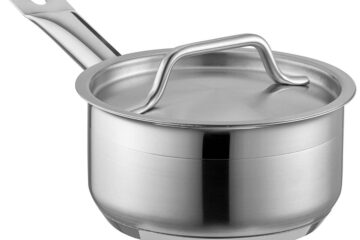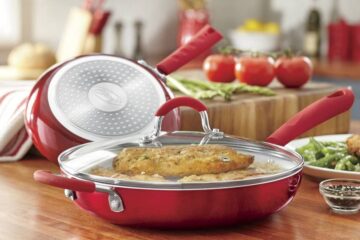Cooking with traditional carbon steel pans and pots is making a comeback in home kitchens. But if you’re unfamiliar with carbon steel cookware, you likely have questions. What is it? How does it compare to other materials? Is it safe and durable? What’s the best brand to buy?
In this comprehensive guide, we’ll cover everything you need to know about cooking with carbon steel, from underlying basics to care tips, top brands, and detailed product reviews. You’ll learn why chefs and home cooks love using classic carbon steel, as well as what to consider when purchasing your first carbon steel pan.
Let’s dive in to the world of carbon steel cookware!
What Is Carbon Steel Cookware?
Carbon steel cookware refers to pots, pans, and skillets made from a combination of iron and carbon. Most carbon steel used for cookware contains around 1% carbon.
This iron-carbon blend results in cookware that’s lighter than traditional cast iron but still offers excellent heat conduction. Carbon steel pans provide an experience on par with cooking directly on metal, perfect for searing meats or whipping up a flawless stir-fry.
While carbon steel may lack the ultra-thick heating mass of cast iron, it boasts superior heat control and responsiveness. Carbon steel allows cooks to swiftly adjust temperature, facilitating cooking tasks requiring precise timing.
Carbon steel derives its name from the added carbon mixed into the iron, distinct from mild steel which contains trace carbon amounts. Manufacturers form carbon steel cookware through processes like pressing, hammering, or spinning. Quality carbon steel has a smooth interior cooking surface without pores for optimal cooking performance.
Though originally favored for specialty wares like woks and crepe pans, carbon steel is gaining popularity for everyday skillets, sauté pans, and stock pots. When properly seasoned and cared for, carbon steel delivers excellent natural nonstick ability. Professional chefs also appreciate carbon steel’s durability in busy restaurant kitchens.
A Brief History of Carbon Steel Cookware
While carbon steel pans may feel trendy, their origins are ancient. Archaeological evidence suggests people have combined iron and carbon to produce steel cookware and tools dating back over 2,000 years.
Traditional carbon steel woks have been used for cooking techniques like stir-frying, steaming, and smoking across Asia for centuries. In 18th century France, crêpe vendors leveraged carbon steel’s superior heating control to cook their delicate pancakes on the streets of Paris.
Today, the timeless benefits of cooking with simple, classic carbon steel appeal to modern cooks seeking natural surfaces and authentic cooking experiences. Interest in the traditional cookware methods our ancestors used continues rising.
Benefits of Cooking with Carbon Steel
What makes carbon steel so beloved by everyone from professional chefs to home cooking enthusiasts? Here are the key benefits of cooking with carbon steel pans and pots:
Natural Nonstick Ability
When seasoned properly, carbon steel develops a natural nonstick patina as fats polymerize onto the cooking surface. This allows cooking with less oil and makes cleanup much easier. The nonstick ability improves over time with continued seasoning.
Unlike synthetic nonstick coatings on many pans, the seasoned surface of carbon steel is extremely durable. There’s no need to worry about scratched or flaking coatings.
Rapid, Even Heating
Carbon steel pans conduct heat quickly and evenly, comparable to aluminum cookware. This allows nimble temperature adjustments, perfect for cooking items requiring precise timing and temperatures like crêpes or omelets.
Superior Searing and Browning
The slick metal surface of carbon steel pans can withstand very high heat. This makes carbon steel excellent for searing meats and achieving the perfect crust on tuna, scallops, or vegetables.
Lightweight Yet Durable
Carbon steel weighs less than traditional cast iron cookware yet still offers impressive durability. Pans feel comfortable and easy to maneuver in your hand. And the material resists warping or denting with proper care.
Versatile for All Cooking Methods
From frying eggs over gentle heat to braising tough cuts of meat for hours, carbon steel works with any cooking technique. Sear meat on the stovetop then transfer directly to the oven.
Requires Minimal Oil
The naturally nonstick surface means food won’t stick, letting you use less added fat while cooking. This results in healthier meals as less oil is absorbed.
Safe for High Heat
Carbon steel has no synthetic nonstick coatings that can degrade at high temperatures. Feel free to crank up the heat for perfect searing.
Long-Lasting
With proper seasoning and care, quality carbon steel cookware will serve your kitchen for many years. It’s a buy-it-for-life investment.
How to Care for Carbon Steel Cookware
While carbon steel pots and pans offer many benefits, they do require some special care. Follow these tips and your carbon steel cookware will provide a lifetime of nonstick cooking.
Season Properly
Seasoning the cooking surface with oil is key to achieving natural nonstick ability. Lodge and other brands often come pre-seasoned, but adding layers of seasoning helps. After cleaning, apply a thin layer of oil and let it polymerize onto the metal in a hot oven. Repeat the process a few times.
Always Hand Wash Gently
Harsh scrubbing can damage the seasoned patina, so handwashing is recommended. Use a soft sponge or brush with a small amount of mild soap. Dry thoroughly.
Oil Lightly When Not in Use
A thin layer of oil helps protect the pan from moisture to prevent rusting. Apply a small amount of vegetable, canola, or other neutral oil before storing.
Avoid Heavy Scouring
Don’t scour carbon steel with abrasive pads or cleansers. This removes the seasoned surface. If food is stuck on, let it soak briefly before washing.
Dry Thoroughly
Since carbon steel can rust, fully dry pans immediately after washing, including around handles. Heat over a burner briefly to evaporate any lingering moisture.
Reseason Periodically
Over time, the patina finish can wear thin in areas. Every few months, reseason following the process of oiling and heating to bolster the nonstick ability.
Best Brands of Carbon Steel Pans
With carbon steel’s popularity, more manufacturers now produce these classic pans. Here are some of the best carbon steel brands available.
De Buyer Mineral B
France-based De Buyer is renowned for its premium carbon steel cookware dating back to 1830. Their Mineral B line is loved by chefs with its rounded pan shape for easy tossing and flipping. Sizes range from 8 to 12.5 inches.
One Amazon reviewer says:
“This pan is a workhorse and a significant step up from a beginner nonstick pan. Takes some work to get it right, but cooks like a dream.”
Darto
Family-owned Darto focuses solely on durable carbon steel pans sustainably made in Latin America. Their pans combine a modern sensibility with vintage craftsmanship. Darto offers skillets, paella pans, and more.
A recent Darto buyer wrote:
“Darto paella pan is a joy to cook in. It’s much lighter than in cast iron but every bit as durable.”
Lodge
Lodge is known for its popular cast iron cookware but also produces excellent pre-seasoned carbon steel options. Their smooth black carbon steel skillets and griddles resist rusting and come in sizes from 8 to 15 inches.
One Lodge carbon steel user mentioned:
“Heats evenly and isn’t too heavy. The right tool for cooking Asian stir frys or anything requiring high heat.”
Matfer Bourgeat
Established in France in 1880, Matfer Bourgeat creates specialized carbon steel pans like crepe pans, woks, and poêlon pur. Their black steel pans are spun in molds for even thickness and prized for heat control.
A recent Matfer Bourgeat purchaser said:
“This is everything you want in a crepe pan. Excellent heat responsiveness for perfect pancake making.”
Carbon Steel vs. Cast Iron
Carbon steel and cast iron share some similarities but also have distinct differences for cooking. Here’s how they compare.
Heat Retention
- Cast iron retains heat extremely well for longer heat conduction during cooking. Carbon steel heats up swiftly but doesn’t retain heat as efficiently.
Weight
- Cast iron pans are heavier, making them excellent for searing but harder to lift. Carbon steel is lighter, making tossing food easier.
Seasoning
- Both materials must be seasoned. However, cast iron seasoning tends to stick better and be more resilient. Carbon steel seasoning requires a bit more maintenance.
Reactivity
- Unseasoned cast iron is extremely reactive to acidic foods. Carbon steel is slightly less reactive if not well seasoned.
Even Heating
- Carbon steel generally heats faster and more evenly than traditional thicker cast iron.
Price
- Quality carbon steel pans are typically less costly than similar cast iron pans.
The ideal choice depends on your specific cooking needs. For dishes requiring precise temperature control, carbon steel is preferable. If you want an ultra-durable pan that holds heat steadily, opt for cast iron.
How Does Carbon Steel Compare to Stainless Steel?
Stainless steel cookware is another popular choice. How does it differ from carbon steel?
Reactivity
- Stainless steel is less reactive than carbon steel. Carbon steel requires seasoning which stainless steel doesn’t.
Durability
- Stainless steel is highly durable, yet carbon steel may have a slight edge with its thinner metal composition.
Weight
- Carbon steel is noticeably lighter than many stainless steel pots and pans.
Heat Conduction
- Stainless steel is a poorer heat conductor. Carbon steel heats evenly and can adjust heat swiftly.
Nonstick Ability
- Carbon steel can be seasoned for excellent natural nonstick. Stainless steel often requires oil or nonstick coatings.
Appearance
- Stainless steel maintains a pristine, modern look. Seasoned carbon steel acquires a darkened patina finish.
Price
- Quality carbon steel is typically less expensive than similar stainless steel cookware.
For cooking tasks like searing meats or stir-fries requiring responsive temperature control, carbon steel will likely outperform stainless. But stainless is lower maintenance with its corrosion resistance.
Is Carbon Steel Cookware Safe?
When properly seasoned and cared for, carbon steel pans provide a safe cooking experience. Here’s how carbon steel safety compares to other common cookware materials.
No Synthetic Coatings
Carbon steel relies on its natural seasoning layer rather than chemical nonstick coatings that can degrade at high heat and leach into food.
Minimal Leaching
The stable seasoned surface minimizes metallic flavors transferring into acidic foods. Reactive unseasoned cast iron leaches iron more readily.
Supports High Heat
Carbon steel is safe at very high temperatures for searing or browning. Overheated nonstick pans can release toxic fumes.
Cleaner Cooking
Food glides across the slick patina, reducing the need for oils that can oxidize or burn at high heat.
Naturally Nonstick
Avoid potential health impacts of ingesting fragmented nonstick coatings. The carbon steel patina stays smooth and intact.
While no cookware is universally safe for every person, for most users properly seasoned carbon steel poses minimal risks and provides health-supporting benefits.
Top 5 Best Carbon Steel Pans
Ready to purchase your first carbon steel pan? Here are 5 highly recommended options to consider across various pans types and price points.
1. De Buyer Mineral B Round Carbon Steel Fry Pan – 12.5 Inch
- Handy rounded shape perfect for tossing foods
- Constructed in France by a carbon steel leader since 1830
- Smooth riveted handle for secure grip
- Geared towards home cooks yet robust for daily use
With its sloped sides ideal for tossing vegetables or folding omelets, this 12.5 inch skillet epitomizes why chefs love De Buyer’s Mineral B carbon steel pans. The pan arrived pre-seasoned with a beeswax coating to augment its natural nonstick properties. This workhorse pan will provide flawless searing and sauteeing for years to come.
2. Darto Paella Pan – 15 Inch
- Iconic shallow design with two handles
- Distributes heat evenly across large surface
- Preferred for authentic paella and rice dishes
- Made sustainably in Latin America
This spacious Darto paella pan opens up new recipe possibilities. The twin loop handles and fitted lid aid in transporting the pan from stove to table for serving. Darto pre-seasons the interior twice for a smooth patina. Reviewers praise the pan’s heat responsiveness critical for perfect paella. A wonderful pan for aspiring paella chefs.
3. Matfer Bourgeat Black Steel Crepe Pan – 10 Inch
- Classic French style carbon steel crepe pan
- Steel span turned over beechwood fire
- Steel is 3mm thick for optimal heat control
- Ideal heat conduction for delicate crepes
With French-made craftsmanship designed specifically for crepes, this Matfer Bourgeat pan excels at cooking paper-thin pancakes. The angled steel handle enables tossing and flipping motion. Heat travels swiftly through the 3mm thick black steel. Once seasoned thoroughly, the surface releases crepes effortlessly. Professional-grade performance for home crepe making.
4. Lodge Carbon Steel Skillet – 10.25 Inch
- Pre-seasoned by Lodge’s renowned seasoning process
- Helper handle provides control and balance
- Pour spouts on both sides
- Affordable pan for everyday use
This budget-friendly pre-seasoned skillet receives high marks for its smooth, nonstick cooking surface. The pour spouts are handy for draining grease from pan frying. Cast iron cookware giant Lodge applies its expertise to deliver exceptional carbon steel cookware value. A perfect starter pan for new carbon steel users.
5. Solidteknics Aus-Ion Wrought Iron Skillet – 10 Inch
- Modern wrought iron pan light like carbon steel
- Sand-cast iron for ultra-smooth interior
- 100% plant-based wax seasoning
- Handmade in Australia
This innovative skillet combines ancient wrought iron with eco-friendly manufacturing. Their unique sand-casting and polishing creates an extraordinarily smooth surface. The durable plant-based seasoning provides a slick beeswax-infused coating right out of the box. Though pricey, it’s a standout modernized carbon steel pan.
Should You Buy Carbon Steel Cookware?
Carbon steel offers a great alternative to traditional nonstick or stainless steel pans. Carbon steel’s natural nonstick patina minimizes oil usage for healthier cooking. And it pairs nonstick convenience with the ultra-high heat searing ability of cast iron.
For cooks seeking vintage charm with modern versatility, carbon steel is an excellent option. Yet it does require some extra care like gentle cleaning and periodic reseasoning to maintain that slick surface.
With numerous shapes and sizes to select, identify what cooking tasks you tackle most. Opt for skillets, sauté pans, or specialty styles like crepe pans or grill pans. And consider your cooking surface; electric ranges may struggle to heat carbon steel evenly.
While pricier than basic nonsticks, quality carbon steel pans offer natural cooking performance comparable to far more expensive cookware. With the proper use and care, your investment will reward you with decades of cooking enjoyment.
Caring for Carbon Steel: Best Practices
To keep your carbon steel as nonstick and rust-free as possible, follow these essential care tips:
- Allow new pans to air dry fully to minimize rust
- Season thoroughly with layers of oil baked in the oven
- Always handwash gently with mild soap and soft brush
- Immediately dry pans thoroughly after washing
- Apply a very thin coating of oil before storage
- Reseason periodically to maintain the patina
Avoid behaviors that degrade the patina like overheating, long soaking, or scouring. While carbon steel needs some extra TLC, taking care of your cookware properly ensures a lifetime of stellar cooking.
Tips for Cooking with Carbon Steel Pans
It may take a few tries to master cooking in carbon steel if you’re accustomed to nonstick pans. These tips will help you adapt:
- Use medium-low preheat settings to give pans time to heat gradually
- Allow cooked foods to release naturally before flipping or removing
- Fry eggs and delicate foods over gentler heat
- Use oil/fat for cooking initially until seasoning is built up
- Deglaze pan with liquid after cooking to clean and enhance fond flavors
- Let pan heat up again before consecutive cooks to re-season
With experience, you’ll determine ideal heat settings and oil amounts for different recipes. Favoring lower heat helps preserve the seasoning.
Common Questions About Carbon Steel Cookware
Does carbon steel work on induction ranges?
Yes, carbon steel pans function on induction stoves since the material is magnetic. Some pans come with an induction plate bonded to the base.
How heavy are carbon steel pans compared to cast iron?
Carbon steel pans are around 30-50% lighter than similar cast iron pans depending on thickness. But they still have excellent heat retention.
Should I get pre-seasoned or unseasoned carbon steel?
Pre-seasoned carbon steel lets you start cooking right away. However, some people prefer seasoning pans themselves for better control.
What oil is best for seasoning carbon steel?
Refined avocado, grapeseed, coconut, and flaxseed oil provide optimal seasoning. Avoid olive oil which can leave a gummy residue.
**Can you use metal utensilsCopy
continue writing where you have left, if anything remaining
W
Here is the conclusion to wrap up the article:
Final Thoughts
Carbon steel pans provide the natural, nonstick cooking ability chefs love without relying on chemical coatings. With proper seasoning and care, carbon steel delivers excellent versatility and durability. It excels at high-heat searing yet also handles gentle cooking tasks.
For cooks seeking more hands-on cookware with authentic charm, carbon steel is an ideal choice. Taking the time to season and care for it properly ensures your pans will outlast inexpensive alternatives.
With so many shapes and sizes available, identify your main cooking needs to select the right carbon steel pan for your kitchen. Precision-made skillets, woks, sauté pans, and more await your next culinary creation.
So consider bringing home your first classic carbon steel pan. And with continued use, the slick patina finish and cooking experience will only get better over time. Once accustomed to carbon steel, you may find yourself reaching for it daily over other pans.



